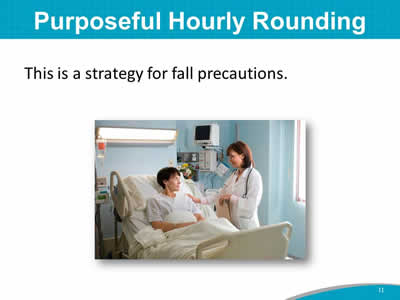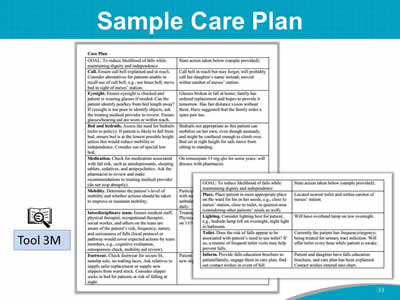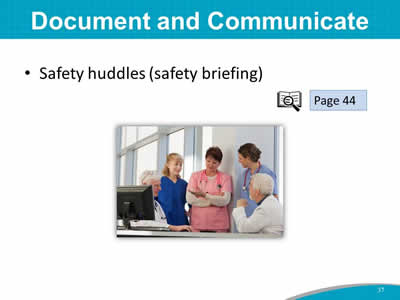

Image: Puzzle pieces are labeled “assess readiness,” “manage change,” “implement practices,” “best practices,” “measure,” “sustain,” and “tools.” The piece labeled “best practices” is highlighted in blue.



The practices selected and used need to be tailored to your hospital and the type of patients and care flow on individual units.
Images: Three photographs show a medical provider holding the arm of upright patient, medical providers standing at a patient’s bedside, and a medical provider escorting a patient walking with IV pole.


Fall prevention becomes embedded into hospital safety culture.

What are your hospital’s universal precautions?
Image: Photograph shows a patient lying in a hospital bed

Images: A table is captioned Inspection List with the following instructions: "Write the unit name, date, and room numbers across the top line. Put the bed number or letter across the second line and sign it. Put an “X” under the room number and bed beside all the tasks that need to be done (leave blank if no safety issue is identified or problem can be fixed immediately). Indicate whether this task should be completed by the nursing staff or facilities staff in the Assigned column. Tasks that are typically completed by the facility engineers are denoted with an “(f).” Write notes about special problems or add details in the Notes column." An icon of a magnifying glass in front of open book identifies the table as Tool 3C.

Images: A sample Environmental Safety Hazard Report is shown. An icon of a magnifying glass in front of open book identifies the report as Tool 3D.
Source: Reprinted with permission. © 2006, ECRI Institute, 5200 Butler Pike, Plymouth Meeting, PA 19462, www.ecri.org.

This is a strategy for fall precautions.
Image: Photograph shows a medical provider at a patient’s bedside

Images: A sample Scheduled Rounding Protocol is shown. An icon of a magnifying glass in front of open book identifies this as Tool 3B.
Reference: Adapted from Meade CM, Bursell AL, Ketelsen L. Effects of nursing rounds: on patients’ call light use, satisfaction, and safety. Am J Nurs 2006;106(9):58-70 with permission.

Image: A triangle represents the 3-Step Fall Prevention Process from top to bottom:
Source: American Geriatrics Society, 2010. Ganz DA, Huang C, Saliba D, et al., 2013. Centers for Disease Control and Prevention.


Image: A triangle represents the 3-Step Fall Prevention Process from top to bottom:

Image: Photograph shows a medical provider holding the arm of patient who sits at the edge of a bed with a mobility device

Assess patients’ ability to use their assistive devices.
Image: Photograph shows a medical provider holding the arm of a patient walking with a mobility device.

Image: Photograph shows a patient taking medicine.


Image: An icon of a magnifying glass in front of open book refers to Page 36.

Images: Icons of magnifying glasses in front of open books identify the tools listed above as Tool 3G, Tool 3H, Tool 3I, and Tool 3J, respectively.

The Morse Fall Scale is most widely used in the United States.
Images: The Morse Fall Scale is shown. An icon of a magnifying glass in front of open book identifies this scale as Tool 3H.



Images: The Morse Fall Scale is shown with sample patient scores.

The questions for your Team to address are:


Image: A triangle represents the 3-Step Fall Prevention Process from top to bottom:

Image: Paper labeled “fall risk.”

Care Plan Documentation
Image: Icon of binoculars.

Image: A triangle represents the 3-Step Fall Prevention Process from top to bottom:

Images: 1. A sample patient checklist including Morse Scale scores for predicting fall risk. 2. Individualized Fall Education Plan. 3. Safety Plan, pages 1 and 2, and a “No falling” warning sign.

Images: Two pages of a Sample Care Plan are shown. An icon of a magnifying glass in front of open book identifies this as Tool 3M.



Image: Photograph shows medical providers using computers and papers for documentation.

Image: Photograph shows medical providers holding a meeting. An icon of a magnifying glass in front of open book refers to Page 44.

Image: Photograph shows medical providers holding a meeting in a hospital corridor. Icon of binoculars.


Image: Photograph shows a medical provider holding a patient's wrist with both hands.



Image: A flow chart depicts a decision tree for types of falls.


Images: Two screenshots show a sample post-fall assessment cliinical review. An icon of a magnifying glass in front of open book identifies this as Tool 3N.



Image: Photograph shows a medical provider using gait belt on patient sitting on a bed. An icon of a magnifying glass in front of open book refers to Page 50.

Images: A sample Action Plan is shown with Key Intervention 2 circled in red. An icon of a magnifying glass in front of open book sits above the text "Refer to your Action Plan template."

Image: A sample Best Practices checklist is shown in table form. The checklist items are:
An icon of a magnifying glass in front of open book identifies the checklist as Tool 3P.
